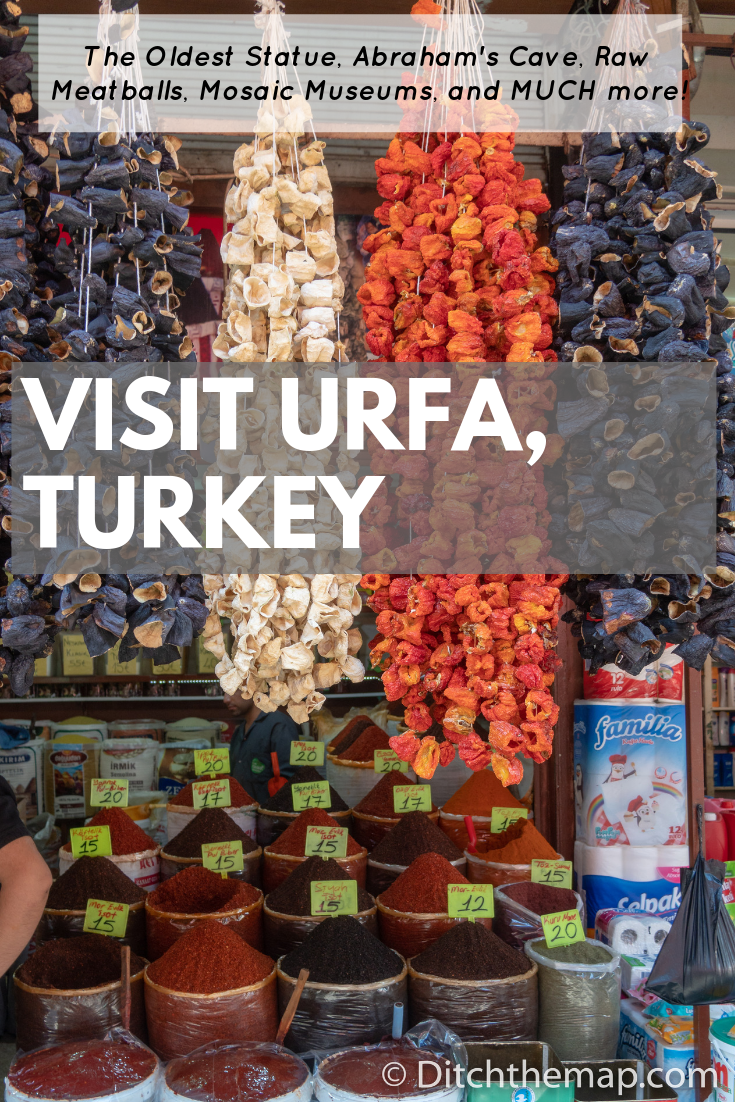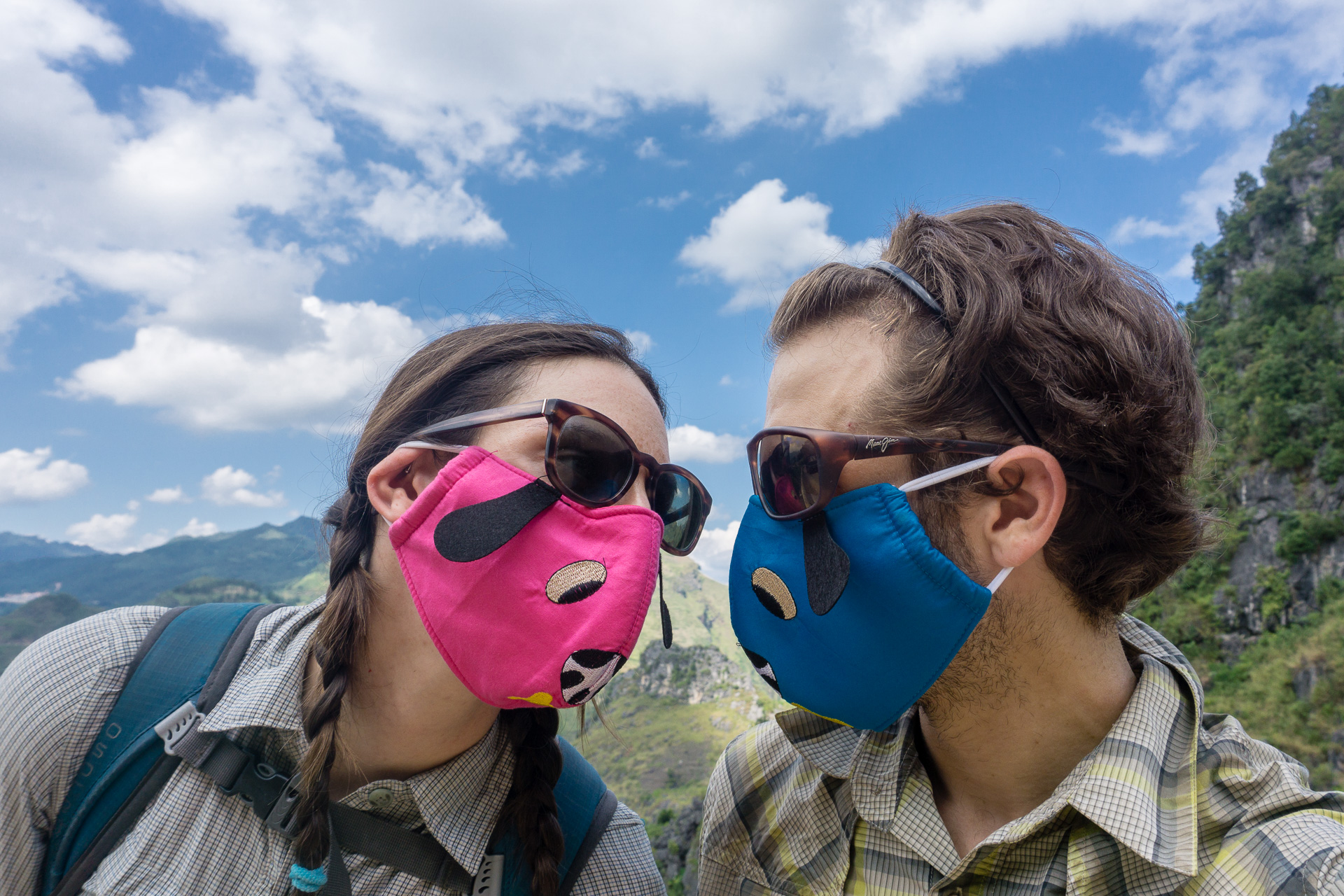Top 6 Things To Do in Sanliurfa, Turkey - The Birthplace of Agriculture and Beyond
/Sanliurfa, or “Urfa” as the locals call it, is one of the oldest inhabited regions on Earth. It was the birthplace of agriculture and home to civilizations predating agriculture, this is evidenced by Göbekli Tepe, a 12,000 year old temple northeast of the city. Göbekli Tepe is 6,000 years older than Stone Hedge! Needless to say, Urfa’s history is vast and the city earned a well-deserved spot on our itinerary. It also doesn’t hurt that our favorite Turkish dish, cig kofte, has its origins in this city.
Sanliurfa, Turkey is represented by the red marker
Different types of head coverings: image from the BBC
Arriving in Sanliurfa (Urfa)
We arrived in Sanliurfa, Turkey by bus after attending a Kurdish wedding in Diyarbakir, a city 2-hours east. Almost immediately we noticed a more conservative dress among the women in Sanliurfa. Whereas in other Turkish cities we observed some women wearing head scarves, a portion of the women walking the streets in Urfa were wearing niqabs, covering their faces, with the exception of their eyes, in black fabric. A handful of men also wore long white tunics and baggy pants called salvar. Arabs comprise a visible minority in the city and Arabic writing is noticeable on store fronts giving the city a Middle Eastern vibe. We also noticed a few intriguing chin tattoos peeking out from a handful of older women’s headscarves and decided to research these mysterious markings. Turns out we were lucky to spot these tattoos as deq facial tattoos are an almost extinct beautification tradition once practiced by certain nomadic, Kurdish, and Arab peoples.
A woman wears a niqab in a market in Sanliurfa, Turkey
A group of men hang out in Golbasi park near Abraham’s Cave in Sanliurfa, Turkey
A Very Brief History of Urfa
Urfa is a spiritual center and pilgrimage sight attracting visitors from all over the world. It is believed to be the birthplace of the prophet Abraham making it an important religious destination. Urfa was fought over by the Persian and Roman Empires and became a center for Christianity until the Arabs took control of the city in 637. The city was originally named Edessa by Alexander the Great, then Urfa in 1637 by the Ottoman Empire, and ultimately renamed Şanlıurfa (Glorious Urfa) in 1984 in the aftermath of the Turkish War of Independence. Urfa is currently home to thousands of refugees from its war-torn neighbor, Syria.
Men sit outside of the bazaar in Sanliurfa, Turkey
What to See and Do in Sanliurfa
1. Stimulate Your Senses at the Gumruk Bazaar and Try Some Local Foods
On our first evening in Urfa we ventured to the Gumruk Bazaar, said to be one of most authentic bazaars remaining in Turkey. We walked through the wood carving and metal welding stalls where sparks flew and machines whirred. Towering piles of crushed red pepper and spices were scattered throughout the marketplace. While staring intently at a curious food item that looked like strands of hair, the vendor, noting our bewilderment, pulled some wisps apart and encouraged us to try it. We tasted the odd treat and the yellow strands clung to Scott’s beard as if he’d eaten a barbie doll. It turns out that Pişmaniye or “fairy floss” is a cotton candy-like dessert but, unlike cotton candy, pismaniye contains butter and flour giving it a rich flavor.
A variety of pepper for sale in Gumruk Bazaar in Urfa, Turkey
Pişmaniye a sweet stringy dessert
Venders inside the Gumruk Bazaar in Sanliurfa, Turkey
Dried vegetables hanging in the Gumruk Bazaar in Sanliurfa, Turkey
We entered a large covered courtyard in the middle of the bazaar which houses several cafes where you can linger and people watch. We tried the local drink, mirra coffee. Only thimble-sized, it’s not a drink to sip on. It’s thick, dark, and super concentrated - what it lacks in flavor in makes up for with the jolt of energy it provides. Fittingly its name comes from the Arabic word “mur” for bitter.
Buzzing cafes inside the Gumruk Bazaar courtyard
Mirra coffee is poured in the Gumruk Bazaar in Sanliurfa, Turkey
Specialty Mirra coffee is served as a single sip inside a tiny cup
Lamb spleen kebab - yep, that is the local dish that Scott insisted we try for dinner. On the outskirts of Urfa’s Gumruk bazaar we sat for dalak kebab. As is customary (and the best thing ever) additional plates of food accompany meals in Turkey. We were served mint, parsley, onions, lemon, and grilled pepper as condiments for our kebabs. The innocuous looking grilled pepper turned out to be sadistically spicy. So painful in fact that we hurriedly ordered the gooey salty yogurt drink, ayran, that we usually avoid, hoping the dairy would cut the spice. It worked! No wonder this drink is the drink of choice with kebab. Urfa is also renowned for Urfa kebab (less spicy than its cousin the Adana kebab) and eggplant kebab. Something to note: because Urfa is a pilgrimage site and a religious destination it is almost impossible to find beer or alcoholic beverages.
We eat dalak (lamb spleen) kebab and chicken kebab for dinner near the Gumruk Bazaar in Sanlirufa, Turkey
Eggplant kebab is another tasty local specialty to try in Sanliurfa, Turkey
2. See the Sacred Fish at Balikli Gol
Balikli Gol, or The Pool of Abraham, is a magnificent manicured lake with a biblical tale. This site is religiously significant as it’s believed that, a long time ago, King Nimrod sentenced Abraham to death but when Abraham was thrown into the burning wood pyre, the flames miraculously turned into water and the logs into fish. The lake is filled with thousands of sacred carp that are well-fed by tourists (you can buy fish food from lake-side venders). Legend has it that if you spot a white carp amongst the grey ones you’ll be blessed but, if you catch or eat a carp from the lake you’ll go blind. The lake is surrounded by a large tidy park and rose gardens. It’s a nice shady place for a stroll and you can grab tea or food from several carts and cafe restaurants on the grounds. We stopped to eat roasted corn from a stall but felt unsettled when a group of needy children begged persistently for the ear of corn.
The Halil-ur-Rahman Mosque frames Balikli Gol, the pool of Abraham in Sanliurfa, Turkey
The view before entering Balikli Gol
The pool of Abraham in Sanliurfa, Turkey
Cig kofte, or “raw meatballs,” are also believed to have originated during the time of Abraham. Folklore states that when all of the wood was collected to make the pyre to burn Abraham a hunter’s wife prepared raw venison without fire. Raw venison, bulgur, spices, onions, tomatoes, red pepper paste and herbs were kneaded together creating spicy raw meatballs. Cig kofte with raw meat was deemed a health risk and banned for consumption in Turkey in 2009. As a result it is difficult, though not impossible, to find cig kofte with raw beef or lamb. Although we love this “now” vegetarian dish we unknowingly tried the meat version in Diyarbakir and dare I say, it was sensational.
A plate of cig kofte - meat-free, spicy, bulgur meatballs, in Sanliurfa, Turkey
3. Crawl into the Cave of Abraham (Ibrahim Halilullah Dergahi)
Abraham, known as Prophet Ibrahim to the Muslims, is believed to have been born in Urfa. The cave where Abraham was born is now a pilgrimage sight for those across many faiths. It is believed that Abraham was born in the cave and remained there for the first few years of his life because king Nimrod commanded that all newborn children be killed. Scott and I entered separately into Abraham’s Cave. The cave has different visiting areas for men and women. Most of the cave is now submerged in water. As I ducked to enter the stone prayer room, an extension of the cave, I was handed a head scarf. Inside women splashed water on their face and drank from a faucet of holy water (further confirming my belief that in Turkey people like full sensory interaction with historic and religious sites). We all peered into the cave which is protected by a glass wall. I noticed that when the women left the cave they exited backwards. Though I wasn’t entirely sure of the reason why I followed suit hoping to appear less ignorant.
The history of the cave written at the entrance
Inside Abraham’s cave in Sanliurfa, Turkey
4. Go to Göbekli Tepe, the Oldest Known Temple in the World
15km northeast of Urfa, in what was known as the fertile crescent, lays the ancient temple of Gobekli Tepe. This historic sight is estimated to have been built around 9500 BC, pre-dating hieroglyphics. It also pre-dates farming and settlements, revealing that religion was around before the establishment of villages and towns. It’s still an excavation site in which only about 5% of the ruins have been uncovered. At the site tall rectangular limestone pillars are engraved with the shapes of animals and arranged in circular formations. These massive pillars, weighing several tons each, were carved before metal tools and pottery were developed. This fascinating temple is changing the way in which archeologists understand history.
This is the site of the worlds currently known oldest shrine or temple complex in the world, and the planet's oldest known example of monumental architecture. Watch this video to have a look at Gobekli Tepe.
T-shaped limestone pillars at Gobekli Tepe near Sanliurfa, Turkey
Stone engravings on limestone pillars at Gobekli Tepe
An animal engraving at Gobekli Tepe
Animal adorned stone pillar at Gobekli Tepe
While eating breakfast one morning in Urfa we met a friendly english-speaking doctor. Overhearing our english, she started a conversation with us and asked about our plans for Urfa. When we mentioned that we planned to visit Göbekli Tepe she offered to drive us there without a moment of hesitation. This is reflective of the hospitable sentiment you can expect to find in Urfa. Unfortunately, our schedule didn’t match up with her kind offer but we were able to take the bus without any trouble. Bus '0’ goes directly to Göbekli Tepe from Urfa several times a day.
Waiting for the bus in Urfa to go to Göbekli Tepe
The bus schedule for Göbekli Tepe
5. Get Lost in History at the Sanliurfa Archeology and Mosaic Museum
The Sanliurfa Archeology Museum is an extensive three story museum which carefully and chronologically displays artifacts from hunter gathers during the Paleolithic era all the way up through the rise of Islam. The findings on display include everyday objects like cooking utensils and jewelry and jaw dropping items like the 11,000 year old “Urfa Man” statue which is “the oldest naturalistic life-sized sculpture of a human." The Sanliurfa Archeology Museum is an incredibly engaging and well-curated museum. Make sure to set a side a few hours to do it justice.
Entrance to the Haleplibahce Mosaic Museum, located next-door to the Archeological Museum, is included in the ticket price of the Sanliurfa Archeology Museum. This small museum was never intended to be a museum at all. In fact, this Roman villa-complex was accidentally discovered in 2006 when the land was cleared to build a theme park. Consequently construction of the theme park was nixed in favor of constructing a museum. The highly detailed mosaics housed inside the museum’s dome are worthy a visit.
Mosaic tile flooring on display at the Haleplibahce Mosaic Museum
The Urfa Man - an 11,000 year old life-sized human sculpture at Sanliurfa Archeology Museum
Mosaic tile flooring, once part of a Roman villa at the Haleplibahce Mosaic Museum
6. Witness the Controlled Chaos of Sanliurfa’s Outdoor Produce Market
We happened to be in Urfa on a Wednesday and stumbled into an frenetic farmer’s market, held every Wednesday and Saturday. There was a lot of commotion and we were captivated by the sights, the smells, the energy and the transactions of the marketplace. Scott photographed the happenings with great interest but the locals and farmers, not overly accustomed to tourists, took an even greater interest in Scott. Many people insisted that Scott take their photos and they smiled in participation. He was approached by at least a dozen people, asked a ton of questions in broken english, and offered a freshly cut melon.
Produce is sold at a twice weekly outdoor market in Sanliurfa, Turkey.
After spending a quick three days in Urfa we reluctantly left the city to head to our next destination, Antakya, which lured us with the promise of a cheesy dessert called kunefe, a local speciality. While riding a local bus to Urfa’s regional bus station the bus driver asked where we were from, sized-up our perception of Trump with a thumbs up/down gesture, pulled the bus over, got up from his seat, walked over to us and tore off a piece of his breakfast simit to share with us. This seemed like the perfect conclusion to our visit in Urfa. His kindness will forever memorialize our pleasant time in this historic city.
A simit, a popular breakfast food, is an o-shaped sesame bread similar to a bagel
Pin this Urfa travel blog post to read it again later.







